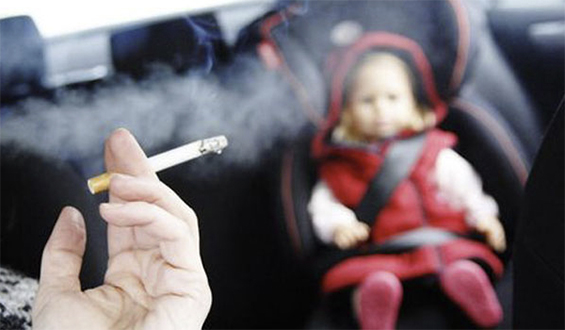
Although there are already multiple reasons not to allow cigarette smoking directly around children, researchers have now found that secondhand smoke may harm children’s teeth. Steven Reinberg writes for Health Day that kids exposed to secondhand smoke at four-months-old could be at risk for cavities by age three.
These children were approximately twice as likely to suffer tooth decay as kids whose mother and father did not smoke, but the research showed that a mother’s smoking during pregnancy did not affect the baby’s teeth.
“Secondhand smoke is one of the major public health problems still unsolved,” said lead researcher Dr. Koji Kawakami, chairman of pharmacoepidemiology and clinical research management at Kyoto University. “In our study, more than half of children had family members who smoked, and most smokers were their fathers.”
Kawakami emphasized that the study showed a link between exposure to secondhand smoke and cavities, not that smoking exposure is the cause of tooth decay. Still, the findings show that increasing efforts to lessen secondhand smoke is prudent. The study was published last week in The BMJ.
According to Dr. Jonathan Shenkin, a clinical associate professor of health policy, health services research and pediatric dentistry at Boston University and a spokesman for the American Dental Association, over the past ten years the association of secondhand smoke to the risk of tooth decay has grown stronger.
The study included information on almost 77,000 children born from 2004 to 2010. Researchers examined the children at birth and at four, nine, and 18 months. The participants were checked again at 3-years of age. Along with this, mothers answered questions about smoking in the home, the children’s exposure to secondhand smoke, the children’s diets, and their dental care.
Approximately 55% of parents involved in the study were smokers, and almost 7% of the children had been in a secondhand smoke environment. In total, up to 13,000 cases of tooth decay were detected.
Yvette Brazier of Medical News Today reports that the level of dental caries in infants’ teeth is 20.5% in kids aged 2-5 in the US and 25% in Japanese three-year-old children. Cavity prevention usually focuses on the restriction of sugar, fluoride supplementation, and fluoride varnish.
Other causes for tooth decay can include physical, biological, environmental, and lifestyle issues. Secondhand smoke may affect teeth by inflaming oral membranes, damaging salivary gland function, and decreasing serum vitamin C levels.
Some limitations of the Japanese study are that it was an observation-only study, so cause and effect could not be shown. There may also have been unmeasured factors that could have influenced the results.
The scientists did conclude:
“Exposure to secondhand smoke at 4 months of age, which is experienced by half of all children of that age in Kobe City, Japan, is associated with an increased risk of caries in deciduous teeth. Although these findings cannot establish causality, they support extending public health and clinical interventions to reduce secondhand smoke.”
Kawakami’s study was not the first of its kind. But previous research involved studying a population at any one given point in time (cross-sectional studies), while this work followed a group of people over time (cohort studies). The latter allows for better isolation of the relationship between two factors, says Ed Cara of Medical Daily.




